
- Index
- Age
- 16th Century (3)
- 1736-1795 (6)
- 17th Century (4)
- 1800-1849 (100)
- 1850-1899 (335)
- 1861-1875 (6)
- 18th Century (18)
- 1900-1940 (195)
- 1950-1970 (4)
- 19th Century (22)
- 20th Century (10)
- 960-1279 (10)
- 960年—1279年 (11)
- Post-1940 (138)
- Post-1950 (4)
- Pre-1800 (479)
- Qing Dynasty (11)
- Unknown (327)
- 1600 (5)
- 1850 (4)
- ... (3191)
- Chinese Dynasty
- Features
- Maker
- Antique (3)
- China (60)
- Chinese (44)
- Chinese Artist (3)
- Chinese Export (10)
- Famille Rose (5)
- Handmade (3)
- Jingdezhen (14)
- Kangxi (3)
- Kangxi (1661-1722) (5)
- Longquan (4)
- Ming Dynasty (3)
- Qianlong (4)
- Qianlong (1735-1796) (9)
- Qing (4)
- Qing Dynasty (10)
- Signed (10)
- Unknown (76)
- Unsigned (4)
- Wan Li (3)
- ... (4606)
- Product
- Type
Jiaqing Seal hexagonal Chinese TURQUOISE Porcelain BOWL w FOO DOGS + Red Paper
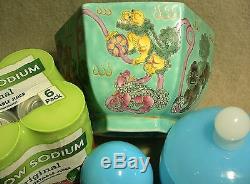
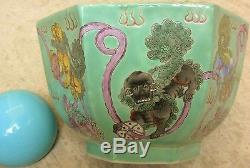
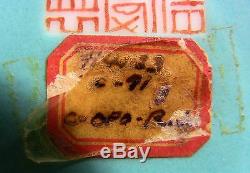
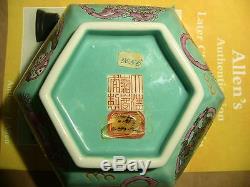
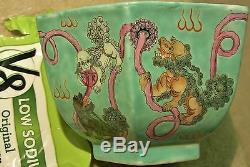
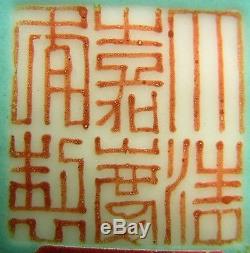
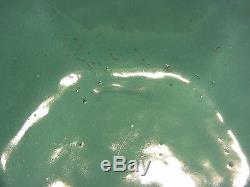
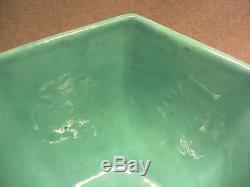
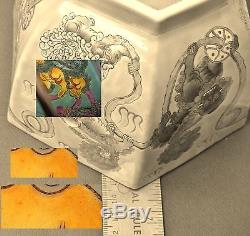

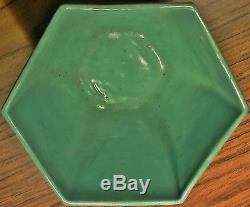
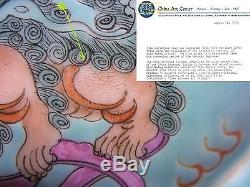


IMPORTANT NOTICE: Please do not ask us to sell your Chinese porcelain objects. If you have been here before, you should know by now that we have a Pinterest site.
Indeed, on our Pinterest site, we have linked pictures from Sotheby's, Bonhams, and Christie's to show samples of authentic Chinese porcelains to make our point. Besides, we know you have been to our Pinterest site since you have bookmarked many of our links. BTW, someone accused us of merely showing off our vase...
Since the price is so high, blah. Well, the Make Offer button is there, is it not? Bright, normal, incandescent spotlight = night photography. Our bowl has been verified as ORIGINAL. Specifically from mainland China (not Taiwan), as evidenced by the official Chinese government's seal of approval.See Picture #3: Wax Seals: Seals applied by Chinese government antique inspectors to certify that the porcelain to which it was applied, were approved for export. It is not a guarantee of age. In some parts of China, the wax seal has been superseded by a red paper label.
ALLEN'S Authentication of Later Chinese Porcelain... Well, acknowledge the fact that it is Mr. Allen's word against the Chinese government's porcelain experts.Regardless, these highly trained Chinese inspectors (of our bowl) were, no doubt, 100% mainlanders (when they were alive), not foreigners... And not Chinese porcelain antique dealers, if you catch our drift. It is important to note that Mr.
Allen also sells Chinese porcelains... So, as a result of his bold statement It is not a guarantee of age. How sure are you that your Chinese porcelain was even created inside mainland China by a Chinese native without a " red paper label " attached to it?
Back to our beautiful piece. Notice the age of the tape on the paper label.
" Thus, what would be called'Scotch' Masking Tape was born in 1925, " says TodayIFoundOut. This bowl was already more than 100 years old in 1925...
If you believe the Chinese government's assessment. Either way, our bowl has the necessary. And it did not come from a restaurant, garage sale, nor swap meet. We will stake our ancestors' names on it -- the Sir who rebuilt many structures in London after the Great Fire, and grand-mama was an "upstairs lady-in-waiting" to Queen Victoria. Why does the condition of your bowl look so gorgeous?
Is this the kind of bowl in which you would serve your noodles, beef stew, or fish sauce? After all, our bowl is a piece of art (but you already know that), a VERY important piece, and. Just imagine the spoon making that clanging noise -- LOL.
Do you really want to make that social error during dinner? Yeah, scrape the corners, Honey, dig in. This is a decorative, mantel piece.We do not abuse our art objects, and the bowl is not gathering dust in our bank's deposit box. " Unless you intentionally abuse, scrub the heck out of it with steel wool, or unscrupulously "age it, porcelain will not show wear for hundreds of years by merely sitting on a table cloth.
Have you ever seen porcelain objects which survived intact after 300 years underwater? Manufacturing anomalies are, however, not the same as (sinister) intentional damage. Our museum-piece bowl is exactly that -- no chips and not a single repair. Furthermore, this is a masterpiece from.
As an aside, there is a very fine hexagonal bowl by Yang Pengnian , a famous Jiaqing period Yixing master. You should not have any problem finding it... And if you do find it, d. Oes the overall shape, including the foot rim, look familiar? F you have been here before, you should know by now that we have a Pinterest site.
Our bowl is, to that end, NOT an "export ware" but a "Chinese taste" bowl. First of all, the motif is religious or mystical, supernatural, spiritual, psychic, superstitious, etc. But definitely not made to amuse the Literalist Christians of yesteryear. Second, the shape will, again, make loud clanging sounds during dinner that could drive any Western mother crazy.
Third, an "export ware" for the American market has no designer label on the bottom, let alone a Jiaqing mark to remind Americans why they left England in the first place. Unlike watching another superhero movie, our foo dogs still excite us.Some kind of impurity in the glaze, or natural aging -- you decide. Regardless, it has caught our dragon-like eyes, more fiery-sharp than Sauron's, no doubt. T he Qing dynasty is famous for the polychrome ornamentation of its many. Pink Family enamels actually were developed in China by Europeans since they were the ones who brought this technique; Famille Rose did not exist in China prior to 1720.
Certain Chinese enamel decorations or palettes are recognized by western or Chinese made-up names which have resulted in a considerable confusion, since they more often than not overlap each other. Examples of such names are wucai, doucai, fencai, yingcai, sancai, susancai, famille verte, famille noire, famille jaune and famille rose. (Jan-Erik Nilsson of Gotheburg fame). If a wannabe (or'expert') tells you that only the 20th century and the latter part of the 19th century produced such varied colors, we are sure that you will know.What to do with that heavy, THICK porcelain in your hands, right?? Colors and manufacturing techniques overlapped during the Qing Dynasty (from the late Kangxi to Xuantong), and anyone who tells you otherwise is a phony. Here is something to think about while you are dissecting our bowl:... The'black heart' of Communism had arrived, and with it the dislike for anything colourful and opulent, according to Anthony J.
Marxist ideas started to spread widely in China after the 1919 May Fourth Movement. Chinese porcelain production was in BIG trouble, no doubt, during 1916 death of Yuan Shikai or. Hung Hsien or Hongxian Emperor... Since China has many dialects, not just one , understand?
O WW2 because of brutal fighting, low to zero production, and Mao in the mix. A facetious student once asked the brilliant professor, Was Mao just another warlord? Well, history is written by the...
Plus, Chinese porcelain experts and fans are still verbally duking it out to this day; too many so-called'facts' spoil the truth. Too many "Google experts, " blah, you finish the sentence. So, does our bowl look funereal to you and anti Imperialist?Did communist China give a thumbs-up to religious motifs? Were communists religious, or into mystical imagery and wizardry? Did they meditate every day and go into trance? Our bowl has symbolic and.
Spiritual / metaphysical meanings, not just BIG monetary value -- of course! It is NOT a communist bowl made during China's heavy-handed communist-infested period? The dot dot dot speaks volumes, especially if you have lived through it. As you can see, we love anything opulent and colorful and "happy" -- who doesn't! We have read somewhere that Chinese artists only used "very dark aubergine" and "almost black brown" (whatever that means) colors to outline (the drawing or image) but never solid, plain, uninteresting black -- when it comes to pre-Daoguang, Jiaqing and early Qing porcelains.Also, from what we recall, this person or'expert' said that this understanding is not easy to figure out, and it will only make sense through years of collecting or seeing many antique pieces in person -- aren't you special. The internet has tons of porcelains that have this plain black which outlines these porcelains and easily disproves this'expert. Indeed, on our Pinterest site, we have linked pictures from Sotheby's, Bonhams, and Christie's.. At any rate, there are too many examples to show you.
"Very dark aubergine, " or "almost black brown" -- our foot! Black is black, no matter how you figure it. Or, did our IQ suddenly drop?
Again, from the late Kangxi to late Qing (since we are only interested in the Qing Dynasty because of our Jiaqing bowl), palettes and techniques. Uring the Qing Dynasty, the Individualists (artists) practiced a deeply personal form of art compared to Traditionalists, Courtiers, Officials, and Professional artists. Artists influenced other artists, just like today. The artistic world of the Qing Dynasty was not a cut-and-dried situation; it was an exciting time to be an artist. You see this inspired enthusiasm on our bowl. Here is so much to say about Chinese porcelain art and techniques, but w. E have shortened this page, for it was getting too long, almost like a magical bible. Bowl has never been washed, at least not by us and check out the condition of the " red paper label " after all these years.We will let the new owner have the honor and pleasure of washing this bowl. We have also added another blowup shot to stimulate the experts' attention. Aside from Pictures #7 (with "peppering, " a good indication of being antique, so experts say) and #8, this (new) uploaded close-up of the enamel (see Picture #10) does... Show the expected impurities, the absence of which in many instances will identify immediately the modern reproductions , to quote Mr.
Ou have come to the right place to satisfy your collector's heart with beautiful imperfections. As you can see from Picture #8, the interior looks bumpy like "orange peel, " or curdled. There are those who say that it is suggestive of the late 18th century, including, of course, Antiques Roadshow. Here is, however, a difference between impurity and badly-drawn. The latter is merely lack of talent or genius.
Be sure to recognize the difference between the two, and this is not a pun for you to start kiki-ing. We, including the Chinese government , believe our piece is from the Jiaqing period (and again, we have info to support our judgment; therefore, keep reading and find out), but belief is not the same as a foolproof fact, or truth. Almost all evaluations rely on hearsay and second-hand knowledge when it comes to Jiaqing and earlier porcelains, unless, of course, you think of yourself as one of the Immortals, and a know-it-all only your word is final because you have survived history, itself!! E do not have that kind of ego, but always k. Our bowl is amazing, on many levels -- just check out the foot rim. The foot rim on a lower quality creation is not usually glazed, but everything is debatable when it comes to quality nowadays, especially since practically everything you see online has a "museum piece" blah. The foot rim is'Awesome! The lip area is not as'absoulutely fabulous,' a fair-weather friend mentioned this in passing.Uring the Song Dynasty, the glazed-foot style was already present. Search the net for the Ru dish (w/ glazed foot rim), Northern Song Dynasty. Thus it commissioned the kilns at Ruzhou, south of the capital, Kaifeng in Henan province, to produce celadons. The potters were ambitious, as they aimed to hide all evidence of the somewhat rough ceramic body by covering it all-over with luminous, mostly crackled glazes in various tones of a subtle blue-green.
Fully enveloped in this glossy green coating the pieces almost looked as if carved from jade. To achieve this, they had to be precariously balanced in the kiln on pointed stilts. This technique of firing fully glazed vessels on small spurs rather than making them stand on an unglazed footring, was not invented by the Ru potters; it had been practised already at other manufactories before. The Ru kilns, however, perfected it by making the marks on the underside as tiny and tidy as possible and by reducing their number to the absolute minimum of three, thereby creating a distinctive characteristic for their wares.Already in 1591 Gao Lian flatteringly referred to the typical spur marks on Ru vessels as'sesame-seed' markings. There are many examples of glazed foot rim. Search for them online, or go to our Pinterest site..
Actually, there are too many examples to list. Therefore, it is correct to say that a g. Lazed foot or bottom is NEVER a good indication that a Chinese porcelain object was made during the 20th century. Did important Chinese porcelain masters leave (or etcetera) China just before and after the communist take over? Being COMPLETELY covered in glaze is nothing new.MISE WARES: Some Yue kilns were producing mise or Secret Colour porcelains for the Tang court during the late Tang period... In 1987 one lot of 14 secret colour porcelains were found in the underground foundation chamber of Famen Pagoda, Fufeng prefecture, Shanxi Province...
These secret colour porcelains were covered with a glaze which was green like lake water, greyish green or yellowish green. The glaze is even and translucent... How does mise wares differ from the normal Yue ware? Based on the documented mise pieces, the only discernible characteristic is the fine workmanship. Most have a greenish, light greenish hue but a small proportion are yellowish green in colour.To say it again, clever manufacturing. Techniques (from other dynasties) overlapped during the Qing Dynasty. So, Chinese porcelain makers did not suddenly forget the technique of putting glaze on a foot rim or bottom. Sudden case of amnesia, or. Boy, was I drunk last night.
We have no doubt that the great pieces are in high-end collectors' homes. The early bird catches the worm. What we see for sale out there are mostly "min yao, " or throw away stuff (of nonsense). A person, who insists t hat a glazed foot is a 20th century invention, is a FOOL, or just plain uninformed.
Regarding the late 18th century (Jiaqing): "Foot rims are generally coarse and unglazed, although a more delicate foot ring occurs on fine pieces , ". According to Jan-Erik Nilsson of Gotheborg fame. NOTE: Just because the base of your porcelain object looks old and dirty does not mean it is automatically old.An unscrupulous expert potter in China has ways of aging a piece, and unfortunately, it is an ongoing practice, so we have been told a number of times. As an aside, not all porcelains from the late 18th and 19th centuries are awful and of poor quality. After all, the Imperial factory was burned in 1853, NOT during the Jiaqing era.
1820 was the last year of the Jiaqing period. Ming porcelain creations are Imperial -- so there. He Jiaqing period happened right after the. Qianlóng period of the Qing Dynasty. This should give you a sense of continuity.In Chinese it is called. Song Shí Lu' and written as. Being a low temperature green glaze, it used copper oxide as the colorant and was first produced in the Y. Ngzheng Period and developed by great strides in the.
Qianlóng Period of the Qing Dynasty. According to Read China 8.
Turquoise Green equals "low temperature green glaze, " to reiterate. As you can see, the color of our turquoise does not look like a nauseating Electric Turquoise, nor anemic blue turquoise. On the other hand, t. He precise hue, or the EXACT color to singularly represent the bowl's turquoise tone, is. Extremely hard (or even impossible).
To capture on digital camera , especially since the hue changes depending on the light, etc. Picture #1 = indoor photography w/ bright halogen, fluorescent, and natural bright-afternoon window-lighting versus... V8 LOW SODIUM's light green color and two Baccarat opaline blue. Picture #2 = patio photography with very bright but indirect, afternoon, late summer, natural sunlight. The others are indoor, nighttime photography w/ extra halogen lighting and bright fluorescent light but NO natural lighting.Picture #7 and #11 look like they have dimmer lighting, but it also depends on the angle of our digital camera. It is sometimes annoyingly picky, especially when it is on automatic mode. Again, our beautiful bowl's turquoise color is hardly blue. It is more like Pictures #1 and #2; use their contents to compare our bowl's truer hue. NEVER, ever , tell us that the turquoise color only happened in one real shade from pre-19th century to Daoguang (the period right after Jiaqing) porcelain objects, however, because you are only going to sound foolish.
So, did you search the net? Did you SEE enough examples?
Have you been freed from your tightly held (foolish) belief... Does the turquoise color on each object look familiar? Yes, learn about your turquoise so as not to get punk'd by appraisers and so-called'experts. It makes one's head whirl, however, why some people spin such false info about turquoise. What is their agenda, to rid themselves of, or sell, their objects (from their "personal porcelain collection")?
Did you hear us say, ... There are helpful old-time collectors out there who will guide you, or point you in the right direction, but they also have a policy against using their names, except when their comments are in a book, or published online, in which case you can quote them.
According to watersilkdragon (Michaela), a collector / blogger. So, these animals (foo dogs/lions) appear on turquoise Jiaqing... Most of the Republic period examples have a multi-coloured key fret. The earlier lions seem to be rounder and more detailed but not universally.
Some have flowing manes and tails, others are very curly, not age related. All have ribboned flower balls, and some lions have the flower balls in their mouths... It is, however, reasonably easy to date them with a combination of shape, ground colour, marks and presence of multi-coloured key fret. In the west, "cloud and thunder pattern" (yunwen) is called "key fret" or "meander border, " but mind you, it is a very old design, older than the Qing and Ming Dynasties, and China did not have a corner on it in ancient times.
As you can see, our'lions' are extremely detailed on. (another plus for our bowl if you accept Michaela's finding). As you can see, these nine (9) celestial lions (foo dogs) are playing among ruyi or ju-i "clouds". During the Qing Dynasty (16441912 AD), ruyi scepters became luxuriant symbols of political power that were regularly used in imperial ceremonies, and were highly valued as gifts to and from the Emperor of China. Since 3 and 9 are considered lucky numbers in Chinese culture, Qing craftsmen elaborated the traditional handle and head type ruyi into two-headed sanjiang-ruyi'3-inlay ruyi' with precious stones set in both heads and middle of the handle and jiujiu-ruyi'9-9 ruyi' presentational sets of nine.Be wary of those who tell you that a cloud pattern is a strong indication of a 20th century porcelain object. We have seen too many 16th century objects with'clouds.
Plus, there is a disturbing assumption that every cloud pattern should look alike, and any design outside the million dollar, antique, porcelain bowl, for example, should be designated as a 20th or 21st century cloud technique. Are people actually suggesting that a majority of Chinese artists (98%) lacked originality back then? That there is no such thing as "stylized clouds" because everything was cloned, xeroxed, or copied? Or that Chinese porcelain makers were merely craftsmen, not artists, because the concept of "artist" is somehow a 20th century phenomenon?
Or even that only a European was capable of being a real artist? Such assumptions are not only absurd historically and intellectually, but they also contain a disturbing undertone of racism and Euro-centrism. Indeed, some artists were more talented than others.
As you can see, our'clouds' are perfect -- high class. Take a look, again and again. Nevertheless, their, those important porcelains, pre-1800 clouds look like ours (and one example is an early to mid 19th century cloud). Our Foo Dogs do not look like those late 19th century, nor 20th century creatures. So, speaking of original , show us some 20th century'dogs' that look EXACTLY like our powerful ethereal lions. Again, our bowl is RARE. And, our foo dogs are complex, spirited, and in constant motion compared to the posing style of the 20th century. Our otherworldly dogs are on a mission. Ours certainly do not look saccharine cute and passive, if all else fails. Oh, how cute, how delightful. On the other hand, lovable and pretty are certainly the last adjectives that come to mind whenever we view the picture of a 17th century fu lion or foo dog -- look for it. The earlier the period, the fiercer and more surreal it appears, and sometimes horrific.Do they remind you of our foo dogs' eye area? Back to our vigorous foo dogs. Peaking of a fine work of art, look at their details.
The artistic execution does not look cheap nor phoned in, unlike many reproduction pieces and works done by individuals with no talent or were they painted by toddlers? Why do our fierce celestial lions sport a queue-like hairstyle? Could this be another pointer -- h'mm? The queue was a specifically male hairstyle worn by the Manchu people from central Manchuria and later imposed on the Han Chinese during the Qing dynasty.
The hair on the front of the head was shaved off above the temples every ten days and the remainder of the hair was braided into a long braid. The Manchu hairstyle was forcefully introduced to Han Chinese in the early 17th century during the Manchu conquest of China.
Forget about ruling with a soft (Imperial Yellow) glove, Chinese men wore the queue throughout the Qing Dynasty with no ifs, ands, or buts. Even our foo dogs obey the Emperor's tyrannical whim. The yellow coloration of one of our foo dogs is a good pointer that our bowl is from the Jiaqing period (late 18th to early 19th centuries).
"Today's potters are having great difficulty duplicating this colour, I understand, because the old pieces used antimony, which gives off a highly toxic and potentially lethal gas, " says Anthony J. Allen in one of his books. The yellow on our bowl is definitely NOT bright lemon yellow, nor anemic yellow. Ask yourself this: Why does it look like the Imperial Yellow's glaze; why does it remind me of the color of egg yolk? Until Ming Dynasty, yellow became the official color of the court, represented the imperial authorities and from that time only served the royal family. General public were not allowed to use this color. For this reason many royal style porcelains, especially these after Ming Dynasty, usually use yellow as main color and other colors as assisting color. Gold and yellow can be considered as the representative color of royal style, most of the royal porcelains have at least one color of these two, according to. Wanqi Chai of the University of Cincinnati. A PDF is available online. Picture #9 shows the close-up of our yellow. Our digital camera is not as powerful as a microscope, darn, since there are those who find that it is important to show the EXTREME close-up of the yellow, especially since they follow certain star. The Chinese porcelain world is quite campy that way. Who's your leader; which is your flock?Our allegiance, of course, goes to those with the most logical, well-researched info (not just some cockamamie, few examples of tired-looking objects with puny pictures and pseudo scientific facts attached to them) since there are several battling factions in the porcelain world. Also, Picture #9 shows the diameter of the bowl. Do you see a messy red smear on our hallmark, or to put it another way, is the red enamel on our seal-mark smudged? Do you see a square outline boxing up our seal-mark?
If you say, "No, " then you win the jackpot. Why do we ask these questions? South East Asian market export pieces from 1860 to the 1920s often have smudged red, square'seal' marks. These marks could say anything, but the porcelain is still mostly from the mid to late 19th century.
We also seriously have to consider the tremendous output of fake pieces who could have any mark, from the 1970s up until today, according to gotheborg. Enamel was often used as the color of the Jiaqing mark. Iron red seal script marks were used on Imperial pieces in both the Jiaqing and earlier Qianlong reigns... I discussed this very matter with the Deputy Director of the Jingdezhen Museum, a couple of years ago, and he confirmed my dating. A Jiaqing mark (attached to an object created during that special period) is not rare.It is time to hack out the previous gossip or old wives' tale that you have meticulously stored in your brain. Saving it for a rainy day, are we? There are too many Jiaqing seal-marks with which to embarrassingly flood Pinterest to counteract this superstition , if you catch our drift -- speaking of social error. They (seal-marks) are also sometimes referred to as Temple marks. They became fairly standard for the Qing dynasty, not quite so standard for the Ming dynasty.
The exactness of the mark for any specific period. Though most appear identical (uniform) for the specific reign they represent, close inspection will reveal many subtle differences. Seal marks often reflect the artists rendition. Can sometimes be helpful in matching certain marks to other pieces marked by the same hand (artist) within the period. The same can be applied to the calligraphic style of marks as well, but the latter falls more in the area of handwriting analysis, according to taimantis dot com.
The calligraphy of our bowl's reign mark is beautiful, do you agree? You certainly will never find "'icing sugar' bubbles, " nor a "hollow line" there.
Besides, these'theories' do not apply to our seal-mark since it is not an underglaze blue. The Jiaqing Emperor was the seventh emperor of the Manchu-led Qing dynasty, and the fifth Qing emperor to rule over China from 1796 to 1820... During his reign, he prosecuted Heshen, the corrupt favourite of his father, and attempted to restore order within the Qing Empire and curb the smuggling of opium into China.
This Jiaqing bowl is absolutely not a Hung Hsien period creation, especially because it does not have a Hung Hsien seal-mark. We have no idea where the appraiser got this far out idea -- see Photo #12.
Do you find it a red flag that the appraiser did not mention the Jiaqing seal-mark? It is also interesting to note that this person did not say anything about the red paper label.On the bottom of our bowl. Strange, to say the least.
By the way, we have the book A Discourse on Hung Hsien Porcelain by Mark Chou. The book has tons of pictures of this period's seal-marks, just to let you know, and the Jiaqing seal is NOT "on the DJ's list, " so to speak.'My name is on the List?
Are we surprised about the appraiser's Hung Hsien snafu? Famous experts make mistakes, too, and experts do not always agree -- so what's new! Come to think of it, experts were not a dime a dozen, at least back in'77, since the "instant-online-expert" still was not an annoying'virus,' so to speak. Today, experts are bouncing off the walls in droves -- thanks to search engines.Google it and own it like you know it, dude. Our cat fits right in since she is also an expert, a YouTube expert-diva. We, however, understand what Mr.
Even though a Hung Hsien bowl is highly collectible and pricier (more often than not) because of its rarity since its emperor Yuan Shikai only ruled China for 83 days (a very short reign indeed), our bowl is NOT from that extremely short dynasty, in spite of the'curious' appraisal (to say it politely). Our piece is more than a century older than the Hung Hsien year, by the look of things. Search on the net for other Jiaqing seal-mark's link. To satisfy your curiosity, or learn something new.
But Keep in mind there are many variations of each seal mark... According to the Taimantis site. Allen get his info; where did his sources get their info? Regarding Jiaqing porcelains, Anthony J. Allen mentions the following in his book Allen's Authentification of Later Chinese Porcelain (1796AD - 1999AD) : I remind readers that they must read Chinese academic publications with some skepticism, for the standards of Hong Kong and Singaporean academic scholarship in relation to Qing ceramics (and later) is surprisingly poor...
These historical records are very unreliable, and the Chinese practice of generalizing has been the cause of many errors in dating... It has taken me many years to appreciate how little some of these native Chinese dealers know of their own history, and at the risk of making yet another dating blunder, I have rejected their assessment. I have rejected their assessment, to reemphasize. Was the person who did our bowl's appraisal (Photo #12) schooled in Hong Kong or Singapore?
"Some of these misunderstandings originate from a Chinese reliance on their hopelessly UNRELIABLE historical records, " according to Mr. With this in mind, where would appraisers get their objective and useful info to value things, especially since they live in this century, not during the Jiaqing era for example? OBE (out of body experience)? Some of the modern fakes, such as the saucer (Fig 29.1 in the book), continue to fool even experienced dealers and auctioneers. As I mentioned in my earlier book, collectors and dealers must learn to look for what is not there and the absence of imperfections in either the glaze or the iron red enamel should be a dead giveaway, he adds.Sounds highly subjective, especially if you do not know what to look for. A remark we hear so often, You are asking too much! (Laura in The Enchanted Cottage). Without historical records, one cannot just use made-up facts.
Thout having the past as part of one's solid foundation and guide, to appraise. An object as a pre-20th century art (or any century for that matter) would be purely illogical and even a joke. The joke's on you! It is almost like saying, It is Jiaqing, duh, because it has the proper shade of color; this is the correct measurement, texture, blah-blah; I know these things because I have lived through the Qing dynasty; I was there, Babe. It becomes a game of "my porcelain is more real-ness than your porcelain" (because so-and-so said so).Which is more valid: Who do you base your facts on? " versus " What do you base your facts on?
Since not everyone can afford to use thermoluminescence for accuracy without marring an object (and depreciating its value) by taking a piece from it, do you see what we are getting at? How accurate is "relative dating"? It is NOT based on ego. Also, always keep in mind that the Chinese government's " red paper label " is on our bowl. We just love to rub that in.Then again, one could ask Ms. John Watling to authenticate an antique Chinese porcelain with their latest forensic test -- watch out, world!
Most of all, one has to consider the fashion of the day. Does one really get obsessive about a 30 or 50 or even a 100-year-old style? China has a LONG history, and a "real Chinese, " an Asian antique store owner in fact, once said, Most Chinese people do not consider a 300 year old object as antique.
And this conversation was during the early 21st century when we were about to put his trendy store online. Did he say this because he wanted our bowl at a much lower price? Regardless, a master potter from the early 20th to mid-19th centuries would not bother reproducing a Jiaqing. Of all the eras to choose from!! Especially since the post Qianlong eras have this bad reputation when it comes to quality.A true artist or master always tries to capture the moment (one's current time), regardless of one's nationality. You must never wish to be like anyone else in this world, unless you want to be a copy.
Copies, of course, yes, can only produce mediocrity. Only a craftsman with no artistic genius copies, or "gives tribute to, " a style from three to twelve decades ago. The artists that we know are the most arrogant creatures in the world. Do you really think real artists, MASTERS, would demean themselves by being mere Zerox machines? A real artist would rather starve, or do something else aside from creating art to avoid destroying his or her core or spirit.
An up-and-coming artist certainly would not create a tribute piece''; it is simply not done. Your artistic career is over when someone tells you to do a tribute piece. So, why create something fake and then mark it with a Jiaqing seal? F all the periods of the Qing Dynasty to choose from!! Again, "Red" was not in vogue.
America was in love with its "modern" culture, and. European art was also the thing to own. Faking a Qianlong, Yongzheng, Kangxi, or Imperial Ming porcelain object is the prevailing scheme. It just happens that the market for Chinese porcelain is trendy right now -- actually since the turn of this century. With their booming wealth, Chinese people living in China want their art back. A cultural giant has to have its art back, especially from its opulent past. It is quite symbolic, if anything else, especially a piece with an old (as in Old World) Western family as its owner. "Consider the past and you shall know the future, " a Chinese proverb. So, is it safe to assume that our bowl's glaze has many valuable or useful imperfections? Take a look and rejoice, right?They are tell-tale signs that our bowl is likely from the Jiaqing period. Even though the body of our bowl has sections with coarse textures Hurray for us!
, coarseness is not common to ALL Jiaqing pieces, at least according to Anthony J. Allen; although, the Taiwanese professor/expert Liu Liang-yu disagrees... But we already know Mr. Allen's opinion on generalizing and Chinese academic publications, don't we? Let us put it another way: Is it right to say that course textures on areas of the body are present on ALMOST ALL Jiaqing pieces?
Please keep in mind, again and again, that Mr. Allen is but one of several respected experts out there. He will even tell you that himself. We love his candor and honesty and most of all, his knowledge...
But there are other long-time collectors out there with far better "toys" (porcelains) and much clearer pictures compared to most of the photos in. Allen's books as examples. Many have the same memory or even longer, regarding Chinese porcelain history through personal experience. Allen is not the only old person in the world, yes?
Aren't Sotheby's, Christie's, and Bonhams' pictures amazing? O disagree with Liu Liang-yu is also a form of generalizing, don't you think?Isn't the appraisal of an object based on the appraiser's generalization, to a certain extent? Are we merely exchanging one generalization for another? Collectors and dealers must learn to look for what is not there...
A haunting reminder by Tony Allen. If you want something done right, do the sleuthing yourself -- do you agree?
(with a phony attitude that he or she is actually doing you a favor). For a measly 1K, on the spot, it should instantly tell you that your object is nothing to sneeze at.
You should do your own sleuthing afterwards. Thankfully, high-end galleries are plentiful where we live, up and down the fabled Pacific Coast Highway, to compare the best from the rest.And, we can actually touch the pieces and inspect them. Most importantly, many high-end antique stores have the actual owners teaching their favorite customers. It is curious to think that someone paid.
(w/ only white lines on its sides), and. Ignore a Chinese porcelain rich in history, such as our bowl. In conclusion, so-called experts are not united when it comes to appraising Chinese antique porcelain objects -- "the battle of the experts" gives it away. The cat is out of the bag, so to speak.
Allen get most of his info aside from his "observations"? ; where did his sources get their info? From Chinese sellers in China overly eager to make a buck? We absolutely do not sell directly to overseas collectors. Please do not hesitate to ask questions. Actual color may vary from pictures due to digital camera phenomenon, lighting, your computer settings, and other factors. More about the number 9.Not only is it a lucky number, but The number nine is special in China as it is seen as number of the heaven... Because nine was considered the number of the emperor, only the most senior officials were allowed to wear nine dragons on their robes and then only with the robe completely covered with surcoats. Lower-ranking officials had eight or five dragons on their robes, again covered with surcoats; even the emperor himself wore his dragon robe with one of its nine dragons hidden from view. A male (foo dog) leaning his paw upon an embroidered ball (in imperial contexts, representing supremacy over the world)... Thank you for stopping by.
This masterpiece will have a tamper-security sticker with a unique serial number -. The item "Jiaqing Seal hexagonal Chinese TURQUOISE Porcelain BOWL w FOO DOGS + Red Paper" is in sale since Tuesday, June 13, 2017. This item is in the category "Antiques\Asian Antiques\China\Bowls".The seller is "parker20021" and is located in Laguna Hills, California. This item can be shipped to United States.
- Color: Turquoise
- Maker: Chinese Artist(s)
- Primary Material: Porcelain & Pottery
- Region of Origin: China
- Type: Bowls

